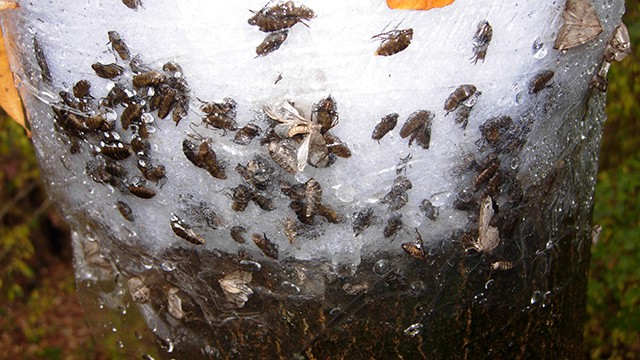Mississauga Facing “Disgusting” Insect Infestation
Published June 6, 2017 at 6:35 pm

If you’ve noticed some nasty little beasties in the QEW and Lorne Park area in Mississauga, you are not alone–there are indeed nasty creatures living among us.
According to a disturbing CityNews report (well, disturbing if you–like most people–hate worms and worm poop), part of Mississauga has been overwhelmed by an influx of cankerworms.
CityNews reported that, for the past couple of days, Lorne Park residents have observed “thousands and thousands” of cankerworms taking refuge in their trees (many of which are quite picturesque and mature) and leaving “a disgusting trail of feces in their wake.”
According to the report, the copious amounts of insect poop have created piles of slush that are making residents wary of leaving their homes.
While this infestation appears to be quite special in its obviousness, cankerworms are common enough pests and the city is working to control them.
According to Ward 2 Councillor Karen Ras’ website, forestry staff was instructed to deliver a notice regarding a cankerworm and gypsy moth ground spray program to residents in her ward last month. According to the report, cankerworm populations are increasing in certain parts of the city, mainly the Whiteoaks neighbourhood.
As for what cankerworms are, the City of Toronto describes the fall cankerworm–a native insect–as one of the most “damaging defoliators” of urban forests. Often called inchworms, loopers or spanworms, the tiny little beasts can be green or brown and their larvae typically hatch and begin feeding on leaves in the spring. After four weeks, the larvae move to the ground and enter the soil. In the fall, the larvae emerge as adult moths.
According to the document, serious cankerworm outbreaks occur every eight or 12 years.
As of now, it appears that 2017 is the year of a more serious infestation.
“Based on monitoring done in 2016 by the City’s Forestry team, fall cankerworm appears to be on a population rise in certain areas of the City. As a result, the City will be conducting a ground spray program on City-owned oak trees in impacted neighbourhoods,” the report on Ras’ website reads. “Additional control measures will be implemented in parks and woodlots where ground spray would not be effective. The areas of higher cankerworm population correspond to areas that have gypsy moth populations as well.”
According to the city, Bacillus thuringiensis subspecies kurstaki (Btk) will be used in the ground spray program to treat for cankerworms in the city. Ideally, the substance will diminish the populations of both cankerworms and gypsy moths (which are not the same thing) in the affected neighbourhoods.
“We will continue monitoring in these neighbourhoods in 2017 and will look at other areas of the City where cankerworm was present but not at higher levels as well,” the report reads.
As of now, the city is only treating trees owned by the municipality, meaning residents with infected trees on private property might need to hire a company or treat their trees on their own.
According to the Toronto document, there are some steps that residents can take to protect their trees, such as installing bands around the main stems of the host trees in October to prevent cankerworm attachment.
Residents can also work to attract birds and ground beetles by planting herbs, flowers, shrubs and groundcovers around the trees, releasing predatory insects such as parasitic wasps, limiting synthetic pesticide use that could harm said predatory insects (they do eat the worms, after all) and looking into applying Btk without the city’s assistance.
Ras also told CityNews that she’s going to introduce a motion regarding spraying for 2018 and on a regular, cyclical basis going forward.
For more info on cankerworm control methods, click here.
Cover photo courtesy of City of Toronto
INsauga's Editorial Standards and Policies








